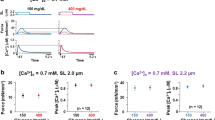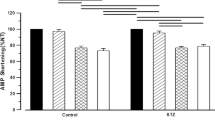Abstract
The objective of this investigation was to determine whether calcium channel blocker (CCB) treatment effectively restores normal baseline mechanical function in diabetic myocardium and to evaluate its effect on the interval-strength relationship. Wistar rats were made diabetic with streptozotocin (55 mg/kg, IV). Left-ventricular papillary muscles from normal and diabetic (10 weeks) rats were superfused with Tyrode's solution at 30°C. A subgroup of diabetic and normal animals received daily injections of verapamil or nifedipine (10 mg/kg, IP; 8 weeks) to compare the effectiveness of a phenylalkylamine to a dihydropyridine in reversing diabetes-induced contractile dysfunction in vitro. Muscles were electrically stimulated at 0.5 Hz with suprathreshold stimuli, and the following parameters were measured: peak tension developed, time-to-peak tension, time-to-90% relaxation, and the maximum velocities of tension development and decay. Experimental diabetes was characterized by: severe hyperglycemia, hepatomegaly, reduced body weight gain, cardiomegaly, and increased plasma phospholipid levels. In addition, baseline values of peak tension developed, time-to-peak tension, and time-to-90% relaxation were significantly greater in muscles from diabetic animals. Chronic nifedipine treatment reduced hyperglycemia and plasma phospholipid levels, normalized body weight gain, and reduced both heart and liver sizes in diabetic animals. Nifedipine treatment completely reversed diabetes-induced prolongation in both time-to-peak tension and time-to-90% relaxation. In diabetic myocardium, a slightly positive component was present in the interval-strength relationship between 0.01 and 1 Hz, resulting in a rightward shift in the entire curve across a wide range of stimulation frequencies (0.01–5 Hz). This positive component was absent in muscles from diabetic animals treated with both CCBs, and verapamil produced a leftward shift in the frequency-response curve. The results of this study suggest that chronic nifedipine treatment may be more effective than verapamil in restoring normal baseline myocardial mechanical function, reducing hyperglycemia and hyperlipidemia, as well as attenuating both cardiac and liver enlargement in experimental diabetes. In contrast, verapamil treatment tended to normalize more effectively the inotropic response to changes in stimulation frequency in diabetic myocardium.
Similar content being viewed by others
References
Fein FS, Diabetic cardiomyopathy. Diabetes Care 13:1169–1179, 1990
Fein FS, Kornstein LB, Strobeck JE, Capasso JM, Sonnenblick EH, Altered myocardial mechanics in diabetic rats. Circ Res 47: 922–933, 1980
Pierce GN, Kutryk MJB, Dhalla NS, Alterations in Ca2+ binding by and composition of the cardiac sarcolemmal membrane in chronic diabetes. Proc Natl Acad Sci USA 80 5412–5416, 1983
Ganguly PK, Pierce GN, Dhalla KS, Dhalla NS, Defective sarcoplasmic reticular calcium transport in diabetic cardiomyopathy. Am J Physiol 244: E528-E535, 1983
Garber DW, Everett AW, Neely JR, Cardiac function and myosin ATPase in diabetic rats treated with insulin, T3 and T4. Am J Physiol 244: H592-H598, 1983
Makino N, Dhalla KS, Elimban V, Dhalla SN, Sarcolemmal Ca2+ transport in streptozotocin-induced diabetic cardiomyopathy in rats. Am J Physiol 253: E202–207, 1987
Dhalla NS, Pierce GN, Innes IR, Beamish RE, Pathogenesis of cardiac dysfunction in diabetes mellitus. Can J Cardiol 1: 263–284, 1985
Nishio Y, Kashiwagi A, Ogawa T, Asahina T, Ikebuchi M, Kodama M, Shigeta Y, Increase in [3H]PN 200-110 binding to cardiac muscle membrane in streptozotocin-induced diabetic rats. Diabetes 39: 1064–1069, 1990
Kashiwagi A, Nishio Y, Ogawa T, Tanaka S, Kodama M, Asahina T, Ikebuchi M, Shigeta Y, Increases in voltage-sensitive calcium channels of cardiac and skeletal muscle in streptozotocin-induced diabetic rats. In: Nagano M, Mochizuki S, Dhalla NS (eds) Cardiovascular disease in diabetes. Kluwer, Boston, 1992
Fein FS, Strobeck JE, Malhotra A, Scheuer J, Sonnenblick EH, Reversibility of diabetic cardiomyopathy with insulin in rats. Circ Res 49: 1251–1261, 1981
Afzal N, Ganguly PK, Dhalla KS, Pierce GN, Singal PK, Dhalla NS, Beneficial effects of verapamil in diabetic cardiomyopathy. Diabetes 37: 936–942, 1988
Kappelle AC, Braveboar B, Traber J, Erkelens DW, Gispen WH, The calcium antagonist nimedipine counteracts the onset of an experimental neuropathy in streptozotocin-induced diabetic rats. Neurosci Res Commun 10: 95–104, 1992
Nayler WG, Slade AM, The cardioprotective effects of verapamil. Clin Exp Pharmacol Physiol (Suppl) 6: 75–87, 1982
Douglas RR, John RC, Barry TM, Kenneth MK, Martin BL, Robert OB, Lewis CL, Stephen EE, Verapamil therapy, a new approach to pharmacological treatment of hypertrophic cardiomyopathy: effects of long-term administration. Am J Cardiol 48: 545–553, 1981
Chatterjee K, Raff G, Anderson D, William W, Parmley W, Hypertrophic-cardiomyopathy-therapy with slow channel inhibiting agents. Prog Cardiovasc Dis 25: 193–209, 1982
Brown RA, Robinson E, Dunbar JC, Inotropic effects of ethanol on the isolated papillary muscle of the diabetic rat. Alcohol 10: 231–235, 1993
Brown RA, Bhasin P, Savage A, Dunbar JC, Chronic verapamil treatment attenuates the negative inotropic effects of ethanol in diabetic rat myocardium. Can J Physiol Pharmacol 72: 1013–1018, 1994
Bligh EG, Dyer WJ, A rapid method of total lipid extraction and purification. Can J Biochem Physiol 37: 911–917, 1959
Chen PS Jr, Toribara TY, Warner H, Microdetermination of phosphorus. Anal Chem 28: 1156–1158, 1956
Ames BN, Dubin DT, The role of polyamines in the neutralization of bacteriophage deoxyribonucleic acid. J Biol Chem 235: 769–775, 1960
Lonsberry BB, Czubryt MP, Dubo DF, Gilchrist JSC, Docherty JC, Maddaford TG, Pierce GN, Effect of chronic administration of verapamil on Ca++ channel density in rat tissue. J Pharmacol Exp Ther 263: 540–545, 1992
Martinez JL, Penna M, Influences of changes in calcium concentration and verapamil on the cardiac depressant effect of ethanol in cat papillary muscle. Gen Pharmacol 23: 1051–1056, 1992
Capogrossi MC, Kort AA, Spurgeon HA, Lakatta EG, Single adult rabbit and cat cardiac myocytes retain the Ca2+-and species-dependent systolic and diastolic contractile properties of intact muscle. J Gen Physiol 88: 589–613, 1986
Koch-Weser J, Blinks JR, The influence of the interval between beats on myocardial contractility. Pharmacol Rev 15: 601–652, 1963
Levy J, Reid I, Halstad L, Gavin JR III, Avoili LV, Abnormal cell calcium concentrations in cultured bone cells obtained from femurs of obese and non-insulin-dependent diabetic rats. Calcif Tissue Int 44: 131–137, 1989
Pierce GN, Afzal N, Kroeger EA et al. Cataract formation is prevented by administration of verapamil to diabetic rats. Endocrinology 125: 730–735, 1989
Chan KM, Junger KD, The effect of streptozotocin-induced diabetes on the plasma membrane calcium uptake activity of rat liver. Diabetes 33: 1072–1077, 1984
Levy J, Grunberger G, Karl I, Gavin JR III, Effects of food restriction and insulin treatment on (Ca2++Mg2+)-ATPase response to insulin in kidney basolateral membranes of non-insulin-dependent diabetic rats. Metabolism 39: 25–33, 1990
Allo SN, Lincoln TM, Wilson GL, Green FJ, Watanabe AM, Schaffer SW, Non-insulin-dependent diabetes-induces defects in cardiac cellular calcium regulation. Am J Physiol 260: C1165–1171, 1991
Nobe S, Aomine M, Artia M, Ito S, Takaki R, Chronic diabetes mellitus prolongs action potential duration of rat ventricular muscles: circumstantial evidence for impaired Ca2+ channel. Cardiovasc Res 24: 381–389, 1990
Fosset M, Jaimovich E, Delpont E, Lazdunski M, [3H]Nitrendipine receptors in skeletal muscle. Properties and preferential localization in transverse tubules. J Biol Chem 258: 6086–6092, 1983
Hess P, Tsien RW, Mechanism of ion permeation through calcium channels. Nature 309: 453–456, 1984
Draznin B, Sussman KE, Eckel RH, Kao M, Yost T, Sherman NA, Possible role of cytosolic free calcium concentrations in mediating insulin resistance of obesity and hyperinsulinemia. J Clin Invest 28: 1848–1852, 1988
Draznin B, Lewis D, Houlder N et al. Mechanism of insulin resistance induced by sustained levels of cytosolic free calcium in rat adipocytes. Endocrinology 125: 2341–2349, 1989
Pershadsingh HA, Shade DL, Delfert DM, MacDonald JM, Chelation of intracellular calcium blocks insulin action in the adipocyte. Proc Natl Acad Sci USA 84: 1025–1029, 1987
Heijiis JB, Mathy MJ, van Zwieten PA, Effect of nifedipine on global myocardial ischemic injury in hearts from diabetic and age-matched controls. J Cardiovasc Pharmacol 18: 542–547, 1991
Fein FS, Cho S, Malhotra A, Aakella J, van Hoeven KH, Sonnenblick EH, Beneficial effects of diltiazem on the natural history of hypertensive diabetic cardiomyopathy in rats. J Am Coll Cardiol 18: 1406–1417, 1991
Hattori Y, Azuma M, Kemmotsu O, Kanno M, Differential sensitivito of diabetic rat papillary muscles to negative inotropic effects of oxybarbituates versus thiobarbituates. Anesth Analg 74: 97–104, 1992
Fein FS, Aronson RS, Nordin C, Miller-Green B, Sonnenblick EH, Altered myocardial response to ouabain in diabetic rats: mechanics and electrophysiology. J Mol Cell Cardiol 15: 769–784, 1983
Sonnenblick EH, Mechanism of myocardial contraction: the myocardial cell structure function and modification by cardiotonic drugs. University of Pennsylvania Press, Philadelphia, pp 173–250, 1966
Author information
Authors and Affiliations
Rights and permissions
About this article
Cite this article
Brown, R.A., Lee, M.M., Sundareson, A.M. et al. Influence of calcium channel blocker treatment on the mechanical properties of diabetic rat myocardium. Acta Diabetol 33, 7–14 (1996). https://doi.org/10.1007/BF00571933
Received:
Accepted:
Issue Date:
DOI: https://doi.org/10.1007/BF00571933




